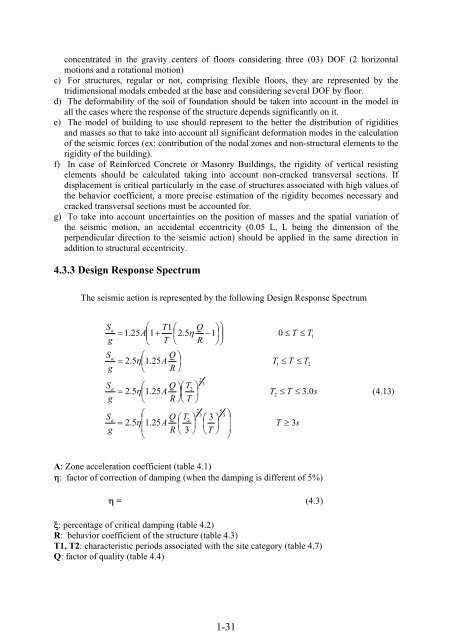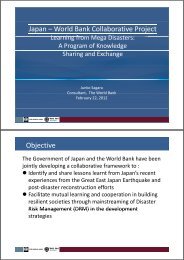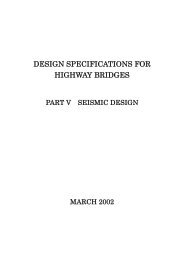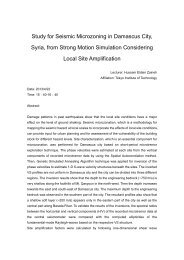algerian earthquake resistant regulations « rpa 99 - IISEE
algerian earthquake resistant regulations « rpa 99 - IISEE
algerian earthquake resistant regulations « rpa 99 - IISEE
You also want an ePaper? Increase the reach of your titles
YUMPU automatically turns print PDFs into web optimized ePapers that Google loves.
concentrated in the gravity centers of floors considering three (03) DOF (2 horizontal<br />
motions and a rotational motion)<br />
c) For structures, regular or not, comprising flexible floors, they are represented by the<br />
tridimensional modals embeded at the base and considering several DOF by floor.<br />
d) The deformability of the soil of foundation should be taken into account in the model in<br />
all the cases where the response of the structure depends significantly on it.<br />
e) The model of building to use should represent to the better the distribution of rigidities<br />
and masses so that to take into account all significant deformation modes in the calculation<br />
of the seismic forces (ex: contribution of the nodal zones and non-structural elements to the<br />
rigidity of the building).<br />
f) In case of Reinforced Concrete or Masonry Buildings, the rigidity of vertical resisting<br />
elements should be calculated taking into account non-cracked transversal sections. If<br />
displacement is critical particularly in the case of structures associated with high values of<br />
the behavior coefficient, a more precise estimation of the rigidity becomes necessary and<br />
cracked transversal sections must be accounted for.<br />
g) To take into account uncertainties on the position of masses and the spatial variation of<br />
the seismic motion, an accidental eccentricity (0.05 L, L being the dimension of the<br />
perpendicular direction to the seismic action) should be applied in the same direction in<br />
addition to structural eccentricity.<br />
4.3.3 Design Response Spectrum<br />
The seismic action is represented by the following Design Response Spectrum<br />
Sa<br />
g<br />
Sa<br />
g<br />
Sa<br />
g<br />
Sa<br />
g<br />
⎛ T1<br />
⎛ Q ⎞⎞<br />
= 1.25A⎜1<br />
+ ⎜2.5η<br />
−1⎟⎟<br />
⎝ T ⎝ R ⎠⎠<br />
⎛ Q ⎞<br />
= 2.5η<br />
⎜1.25A<br />
⎟<br />
⎝ R ⎠<br />
⎛ Q ⎞⎛<br />
T2<br />
⎞<br />
= 2.5η<br />
⎜1.25A<br />
⎟⎜<br />
⎟<br />
⎝ R ⎠⎝<br />
T ⎠<br />
⎛ Q T2<br />
2.5 ⎜ ⎛ ⎞<br />
= η 1.25A<br />
⎜ ⎟<br />
⎜ R 3<br />
⎝<br />
⎝ ⎠<br />
2<br />
3<br />
2<br />
3<br />
5<br />
3<br />
⎛ 3 ⎞<br />
⎜ ⎟<br />
⎝ T ⎠<br />
⎞<br />
⎟<br />
⎟<br />
⎠<br />
T ≤ T ≤ T<br />
T<br />
2<br />
0 ≤ T ≤ T<br />
1<br />
≤ T ≤ 3.0s<br />
T ≥ 3s<br />
2<br />
1<br />
(4.13)<br />
A: Zone acceleration coefficient (table 4.1)<br />
η: factor of correction of damping (when the damping is different of 5%)<br />
η = (4.3)<br />
ξ: percentage of critical damping (table 4.2)<br />
R: behavior coefficient of the structure (table 4.3)<br />
T1, T2: characteristic periods associated with the site category (table 4.7)<br />
Q: factor of quality (table 4.4)<br />
1-31








